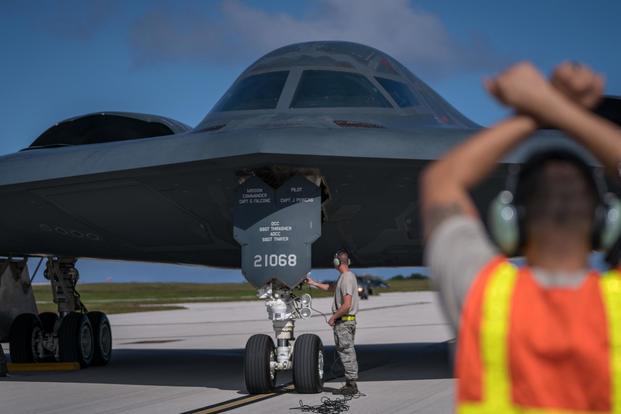The US has been quietly amassing firepower in the Pacific during a lull in tensions with North Korea, but recent developments on an under-the-radar nuclear weapon suggest preparation for a potential tactical nuclear strike.
The US recently sent B-2 stealth bombers to Guam, where they joined B-1 and B-52s, the other bombers in the US's fleet.
While the B-2 and B-52 are known as the air leg of the US's nuclear triad, as they carry nuclear-capable air-launched cruise missiles, a smaller nuclear weapon that has undergone some upgrades may lend itself to a strike on North Korea.
The B-61, a tactical nuclear gravity bomb that the B-2 can carry 16 of, has been modified in recent years to increase its accuracy and ability to hit underground targets, though that version has not yet been deployed.
Not only will the B-61's new modification make it ideal for destroying dug-in bunkers, the kind in which North Korean leader Kim Jong Un might hide during a conflict, but it has an adjustable nuclear yield that could limit harmful radioactive fallout after a nuclear attack.
Though the US has plenty of nuclear weapons that can easily hit North Korea from land, air, or sea, they're predominantly large ones meant to deter countries like Russia or China.
A 2017 paper in MIT's International Security journal suggested that recent advances in guidance systems and nuclear weapons could allow the US to destroy all of North Korea's nuclear infrastructure while causing 100 or so deaths, versus 2 million to 3 million deaths on both sides of the 38th parallel without them.
But Melissa Hanham, a senior research associate at the James Martin Center for Nonproliferation Studies, suggested the paper was flawed.
Hanham told Business Insider that the paper's supposition that only five sites would constitute the bulk or entirety of North Korea's nuclear infrastructure stood without merit.
North Korea has gone to great lengths to deter nuclear or conventional strikes by spreading its nuclear infrastructure across the country. The sites are shrouded in secrecy, and the US intelligence community, despite its best, concerted efforts, has been wrong about their locations before, a former State Department official told Business Insider.
Despite evidence that tactical nuclear weapons won't solve the North Korean military quagmire, President Donald Trump's administration has looked favorably on smaller nuclear weapons.
Trump's recent nuclear posture review recommended building more small nuclear weapons, as their size would make them easier to use in a conflict — something the International Security paper supports.
The B-61 bombs live in military bases spread across Europe and are much less visible than big bombers, whose movements are often publicized. For example, The Aviationist reported in October that a civilian with a handheld radio scanner intercepted B-2 and B-52 pilots over Kansas training to pull off a strike on North Korean VIP targets.
Recent reports have suggested Trump is considering a "bloody nose" strike on North Korea, or a move designed to embarrass Kim by responding to a missile launch or nuclear test with the limited use of force.
But experts and politicians have characterized the idea of a nuclear strike as destabilizing and frankly crazy. Rep. John Garamendi, a California Democrat on the House Armed Services Committee, questioned the wisdom of it in an interview with Business Insider.
"Certainly, North Korea understands that the US is pretty tough," Garamendi said. "The US is prepared and willing to respond to aggression by North Korea."
He added: "But we must assume that if we were to do a bloody-nose attack, that North Korea would respond in some way. Then what?"
More From Business Insider:
- Here's how the US's nukes compare with Russia's
- Here's how easy it is for the US president to launch a nuclear weapon
- A Navy SEAL explains why you should end a shower with cold water
- The US appears to be quietly preparing for nuclear war with North Korea
- 10 reasons companies should hire military veterans













